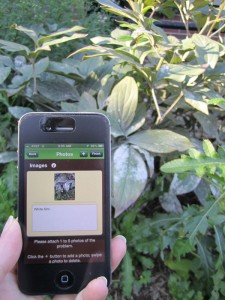Happy New Year!
 In the spirit of the season, here’s a resolution for all of us.
In the spirit of the season, here’s a resolution for all of us.
Identify a plant’s problem before you treat it. I can’t emphasize this enough. This means knowing the problem with a plant is frost damage and not an insect or disease, which would mean you wouldn’t have to do anything. Or, that the problem is a fungus and not a bug, which means you might need to use a fungicide rather than an insecticide.
Knowing what’s wrong with your plant before you treat it saves you money. Why spend money for an insecticide when the problem with the plant was frost damage? Knowing what you have also reduces the use of unneeded chemicals, which is good for the environment.
Plants die. They just do. It’s worse when there’s some sentimental value to the plant, such as the death of an iris transplanted decades ago from the family farm. Or, the summer show of annuals that croaked long before fall’s frost.
 We can look at this a couple of ways. Whatever you do, don’t beat yourself up. We can just accept the loss and replant, or if that spot in the landscape has been nothing but trouble, we can try to figure out what is going on. Does the soil stay too wet or dry? Too much shade or sun? Is there something with the soil?
We can look at this a couple of ways. Whatever you do, don’t beat yourself up. We can just accept the loss and replant, or if that spot in the landscape has been nothing but trouble, we can try to figure out what is going on. Does the soil stay too wet or dry? Too much shade or sun? Is there something with the soil?
Purdue Extension’s Plant & Pest Diagnostic Laboratory is a great resource to solving problems in the landscape. Gardeners can submit samples, which will be analyzed by the Purdue profs, who issue a report within a few days and make recommendations on what to do. I used this service a couple times in 2013 to figure out why shrubs were dying in a client’s landscape. There’s a small fee. The website gives all the information needed to submit a sample.
Purdue Extension also has issued several apps for iPhones and other smart phones to identify or diagnose plant insect and disease problems, and to submit sample photos. Info about these can be found on the website.
Lastly, be sure to take time to enjoy the colors, fragrances, textures and bounty of our landscape. May you and your gardens grow healthy and happy in 2014.